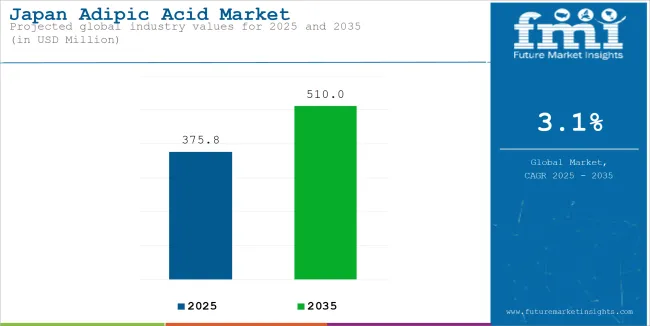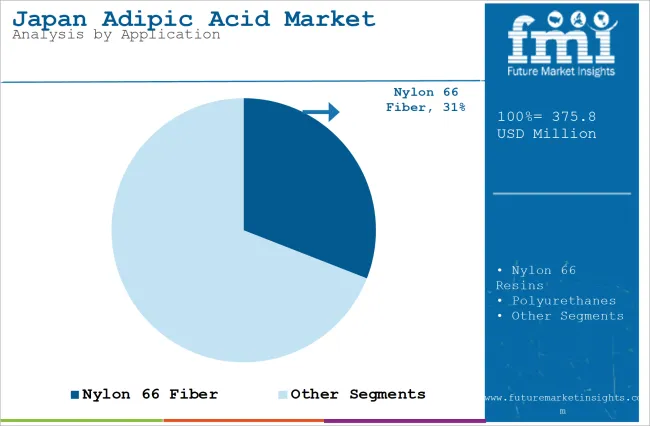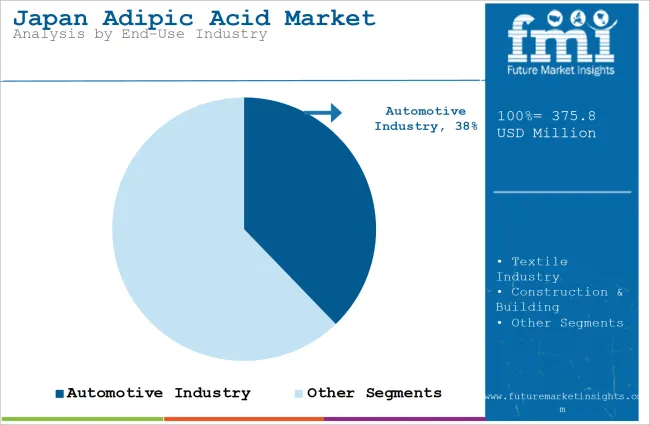The Japanese adipic acid market is expected to exhibit stable growth over the review period, with an estimated market value of approximately USD 510 million by 2035 and growing at a CAGR of 3.1% between 2025 and 2035.
Sustainability is the first driver of this expanding market, while technology is further supporting the demand for eco-friendly and innovative chemical solutions. The major sectors that demand adipic acid are automotive, textiles, construction, food and beverages, and packaging.

| Attributes | Description |
|---|---|
| Projected Japan Adipic Acid Market Value (2035F) | USD 510 million |
| Value-based CAGR (2025 to 2035) | 3.1% |
Strong policy push by the Japanese government to reach net-zero carbon emissions by 2050 created an increased market for sustainably produced chemicals and green solutions. This is more intense in industries whose primary use for adipic acid is the manufacturing of high-performance materials such as nylon, plasticisers, and food additives.
For example, in the automobile industry, in which adipic acid is utilized for lightweight auto parts like nylon and polyurethane, the primary focus has been on energy efficiency and low carbon footprints with the demand for greener products on the rise among consumers, adipic acid will continue to see its usage expand in helping industries meet increasingly stringent environmental regulations.
Eco-Friendly and Bio-Based Adipic Acid
Bio-based and renewable alternatives are gaining a lot of importance in the Japanese adipic acid market. Bio-based adipic acid, produced from renewable feedstock, is fast becoming popular since it offers an environment-friendly solution against the conventional fossil-based production route.
This is very much in tandem with the stricter environmental regulations set by the Japanese government, aiming at sustainable manufacturing processes and green chemicals. Bio-based adipic acid is a bio-based material used by automotive and textile industries for sustainability goals, minimizing environmental footprint.
Advancements in Nylon and Polyurethane Manufacturing
Adipic acid continues to be a core intermediate in the synthesis of nylon 66, largely used by car and textile producers to create strong materials for both sectors. High demand for weight-saving, sustainable, and hard-wearing auto materials will fuel higher adipic acid consumption by automobile manufacturers.
Other significant uses of adipic acid are in the manufacture of polyurethanes used in the construction industry for energy-efficient insulation materials and in the automotive industry for various components. As Japan puts great emphasis on energy efficiency and ecologically friendly building standards, demand for polyurethane-based insulation and other materials will further enhance the demand for adipic acid.
Sustainability in Packaging and Food Additives
The food and beverage industry is in Japan is beginning to experience a rising demand for sustainable packaging materials and food additives; one such product used in these is adipic acid. Demand for adipate esters, a derivative of adipic acid, is gaining momentum in the production of plasticizers for food packaging.
As Japan progresses toward being a more environmental-friendly county through its recycling initiatives, as well as stricter regulations on plastic waste management, adipic acid is more and more used to develop greener, recyclable packaging solutions for the food and beverage industry, which focuses even more on sustainability and reduction in use of preservatives.


| Segment | Nylon 66 Fiber |
|---|---|
| CAGR (2025 to 2035) | 4.2% |
| Key Trends | Increased demand for lightweight materials in the automotive and textile industries. |
| Segment | Polyurethanes |
|---|---|
| CAGR (2025 to 2035) | 4.6% |
| Key Trends | Growth in energy-efficient construction and automotive insulation. |
| Segment | Food and Beverage Additives |
|---|---|
| CAGR (2025 to 2035) | 4.0% |
| Key Trends | Focus on reducing preservatives and increasing sustainability in food packaging. |
| Segment | Plasticizers |
|---|---|
| CAGR (2025 to 2035) | 4.3% |
| Key Trends | Growth driven by the shift towards recyclable and eco-friendly plastic products. |
The Japanese adipic acid market is moderately consolidated. Here, the major global players have a strong hold with local companies in competition for the supply of conventional and bio-based adipic acid solutions.
Among the key global players are BASF SE, DuPont, and LANXESS. The companies' high R&D capabilities and innovation of products hold an upper hand in the market. These companies also invest much in sustainable solutions by focusing on producing bio-based adipic acid and developing its new applications
Domestic Manufacturers
Mitsubishi Chemical and Sumitomo Chemical, prominent companies of Japan, are key players in the adipic acid market of domestic arena. Some of the domestic industry segments these companies cater to include automotive, textiles, food, etc.
Emerging Innovators
With regards to interest in adipic acid production in Japan, studies suggest that because of the growing number of emerging firms exploring new feedstock, like renewable biomass and waste material, it is expected to have significant growth.
| Date | Key Development |
|---|---|
| January 2025 | BASF launched a new bio-based adipic acid product aimed at the automotive sector. |
| March 2025 | Sumitomo Chemical announced an expansion of its adipic acid production for sustainable applications. |
| October 2025 | Mitsubishi Chemical unveiled a new biotechnological process for producing adipic acid from renewable resources. |
The adipic acid market in Japan is set to grow due to several key factors, including a strong focus on sustainability, technological innovations, and the expansion of major industries like automotive, textiles, and food. Factors shaping the future of the market include:
The market is expected to reach USD 510 million, growing at a CAGR of 3.1%.
Nylon 66 fiber is the largest application, particularly in automotive and textile industries.
Key trends include the adoption of bio-based adipic acid, sustainability in packaging, and innovations in nylon and polyurethane manufacturing.
Major players include BASF SE, DuPont, LANXESS, Mitsubishi Chemical, and Sumitomo Chemical.






Full Research Suite comprises of:
Market outlook & trends analysis
Interviews & case studies
Strategic recommendations
Vendor profiles & capabilities analysis
5-year forecasts
8 regions and 60+ country-level data splits
Market segment data splits
12 months of continuous data updates
DELIVERED AS:
PDF EXCEL ONLINE
Japan Respiratory Inhaler Devices Market Size and Share Forecast Outlook 2025 to 2035
Japan Halal Tourism Market Size and Share Forecast Outlook 2025 to 2035
Japan Automated People Mover Industry Size and Share Forecast Outlook 2025 to 2035
Japan Automotive Load Floor Industry Analysis Size and Share Forecast Outlook 2025 to 2035
Japan Food Cling Film Market Size and Share Forecast Outlook 2025 to 2035
Japan Polypropylene Packaging Films Market Size and Share Forecast Outlook 2025 to 2035
Japan Probiotic Yogurt Market is segmented by product type, source type, nature type, flavor type, fat content, sales channel and key city/province through 2025 to 2035.
japan Tortilla Market - Growth, Trends and Forecast from 2025 to 2035
Japan Cosmetics ODM Market Analysis - Size, Share & Trends 2025 to 2035
Japan Automotive Turbocharger Market Insights – Demand, Size & Industry Trends 2025–2035
Japan Yeast Market Insights – Demand, Size & Industry Trends 2025–2035
Japan Green and Bio-based Polyol Market Insights – Demand, Size & Industry Trends 2025–2035
Japan Natural Food Color Market Trends – Growth, Demand & Forecast 2025–2035
Japan Coated Fabrics Market Growth – Trends, Demand & Innovations 2025–2035
Japan Barite Market Growth – Trends, Demand & Innovations 2025–2035
Japan 1,4-Diisopropylbenzene Market Growth – Trends, Demand & Innovations 2025–2035
Japan Compact Construction Equipment Market Insights – Demand, Size & Industry Trends 2025–2035
Social Employee Recognition System Market in Japan - Growth & Forecast 2025 to 2035
Japan Inkjet Printer Market - Industry Trends & Forecast 2025 to 2035
Japan HVDC Transmission System Market - Industry Trends & Forecast 2025 to 2035

Thank you!
You will receive an email from our Business Development Manager. Please be sure to check your SPAM/JUNK folder too.
Chat With
MaRIA